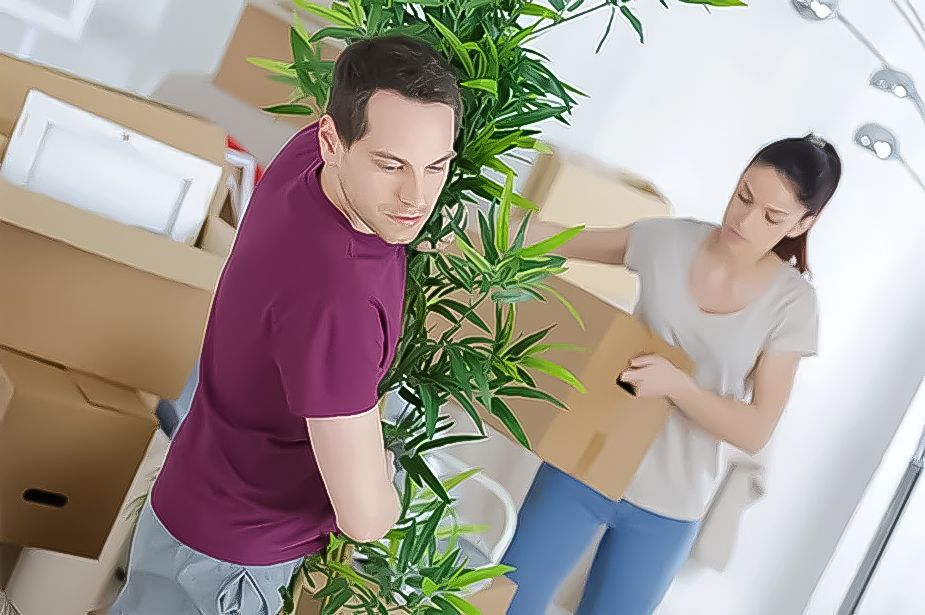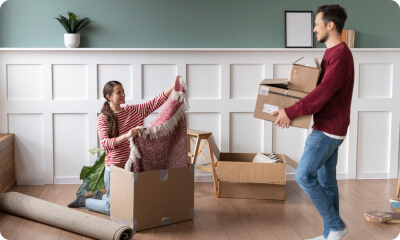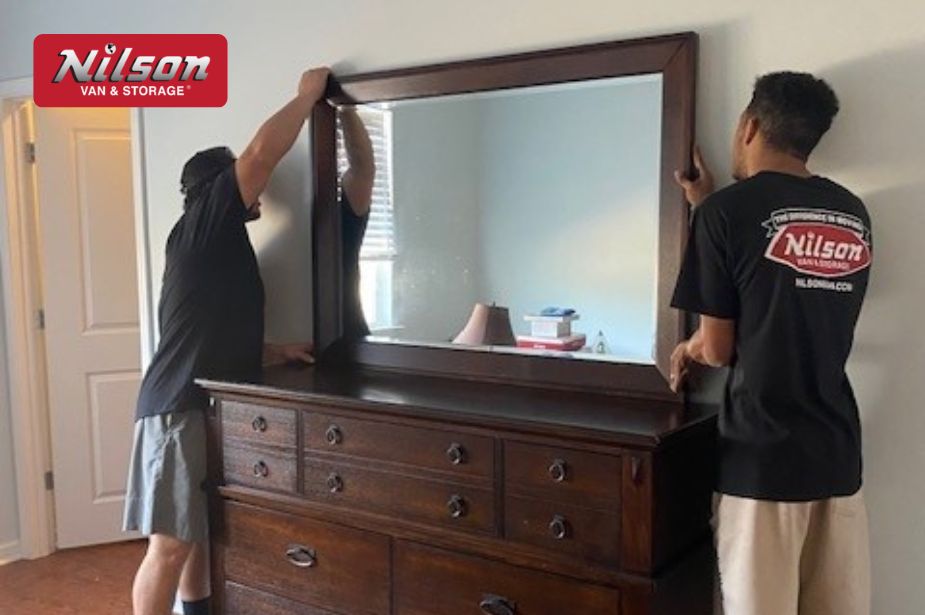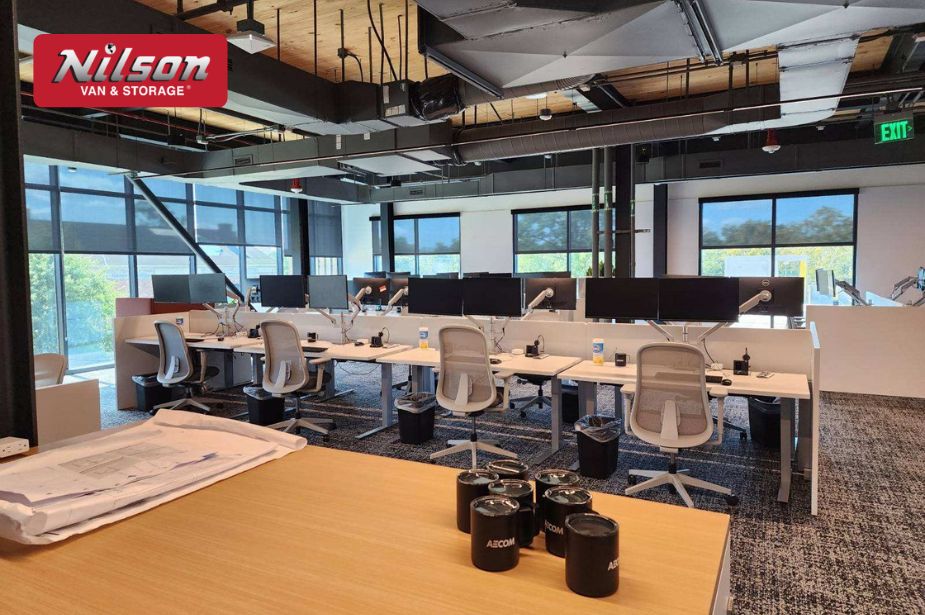
Moving Your House Plants: How To?
Moving your house plants is often an overlooked yet crucial part of planning a residential move. Plants bring life and personality to your home, and relocating them safely requires a thoughtful approach. At Nilson Van and Storage, we recognize that moving your house plants isn’t just about transporting objects—it’s about preserving living organisms that need special attention throughout your move. Whether you are relocating within South Carolina or heading to nearby Savannah, the process of packing plants for moving involves careful preparation to minimize stress and ensure their health during transit.
Understanding how movers handle plants is essential for anyone looking to keep their greenery thriving before, during, and after a move. Unlike inanimate belongings, houseplants respond sensitively to environmental changes such as temperature fluctuations, exposure to sunlight, and the jostling that naturally occurs during transportation. This sensitivity is why moving houseplants safely goes beyond just putting them in boxes. It involves selecting the right containers, cushioning to prevent damage, and considering the duration of travel, especially in regions like Columbia, Myrtle Beach, Charleston, Sumter, and Savannah where seasonal weather variations can influence plant health.
With Nilson Van and Storage’s expert moving services—including flexible, non-binding local moves in SC and valuation protection—you can feel confident that your plants and belongings are handled with professionalism and care at every stage. This guide will offer tips for transporting plants effectively, whether you’re considering a DIY approach or are curious about how movers Columbia SC trust manage living cargo to guard against stress and damage.
Understanding the Challenges of Moving Your House Plants
Why Moving Plants Requires Special Care
Moving your house plants involves more than simply picking them up and placing them in a vehicle. Plants are living organisms that thrive under specific environmental conditions, and any sudden changes during a move can cause stress or damage. Temperature fluctuations are a primary concern; extreme heat or cold during transit can quickly weaken a plant’s health. Likewise, exposure to drafts or lack of ventilation in a moving truck may dry out fragile leaves or break delicate stems.
Handling is another critical factor that requires special care. Unlike furniture or boxes, plants have fragile branches and leaves that are easily crushed or broken. Rough handling can cause physical injuries leading to disease or long-term decline. Additionally, the movement during transit can loosen soil, disturb roots, or cause pots to tip, all of which can impact the plant’s stability and overall health. Moving your house plants safely means anticipating these sensitivities and acting deliberately to protect their well-being throughout the journey.
Common Problems When Transporting Plants
When packing plants for moving, several common problems can arise if precautions are not taken. Soil spillage is one such issue; without proper containment, soil can scatter inside boxes or vehicles, leading not only to messes but also to root exposure that stresses the plant. Broken branches and stripped leaves often happen when plants aren’t supported or cushioned inside their containers—these injuries can stunt growth or invite pests and infections.
Temperature shock during transport is another frequent challenge, especially on longer moves or in weather extremes. A sudden change in climate conditions can cause leaf drop, wilting, or slowed growth. Moreover, accidental neglect can occur if plants aren’t prioritized during loading and unloading. They may be subjected to prolonged darkness, heat, or lack of water, all of which can harm sensitive species. Because these risks vary depending on the type of plant and moving circumstances, understanding how movers handle plants is crucial for mitigating damage.
How Regional Climates Affect Plant Relocation
The climates in South Carolina and neighboring Georgia cities such as Columbia, Myrtle Beach, Charleston, Sumter, and Savannah each present unique considerations for moving houseplants safely. Coastal areas like Myrtle Beach and Charleston tend to be more humid and warmer, which can benefit many tropical plant species during transit but may also increase the risk of overheating if ventilation is poor. Conversely, Columbia and Sumter experience more temperature variation, especially in fall and winter, requiring careful timing and protective measures to avoid cold exposure.
Savannah’s subtropical climate may pose challenges during the hottest months, when even brief trips without adequate shading or airflow can stress plants. Knowing these regional differences helps you plan the timing of your move and select proper packing methods to buffer plants from abrupt environmental shifts. Working with experienced movers Columbia SC residents trust—like Nilson Van and Storage—ensures your plants’ needs are prioritized. Their expert approach, combined with flexible, no-cancellation-fee policies and valuation coverage, supports safe transport tailored to local climate realities and your specific relocation schedule.
Moving Your House Plants: Essential Preparations Before the Move
Assessing Which Plants to Move
Before moving your house plants, it’s important to evaluate which ones you should bring along. The decision often depends on the distance you’ll be traveling, the health and size of each plant, and legal restrictions on transporting certain species. If your move is local within cities like Columbia or Charleston, most plants can adapt well to the journey with proper care. However, longer trips, such as moving from Myrtle Beach to Savannah, may require you to consider whether delicate or large plants will endure the transit safely.
Health is a key factor; plants that are already struggling with pests, disease, or unhealthy roots may not survive the stress of relocation. In some cases, it could be more practical to replace those plants after settling into your new home. Additionally, certain plants are regulated under state and federal guidelines to prevent spreading pests and diseases. It’s wise to check local regulations, especially when crossing state lines between South Carolina and Georgia, to ensure compliance. Taking the time to assess your plants carefully helps streamline packing plants for moving and reduces potential hassles.
Proper Potting and Pruning Techniques
Preparing your plants beforehand can greatly improve their chances of surviving the move unharmed. Start by pruning any dead or excess foliage to reduce weight and make plants easier to handle. Trimming overgrown branches prevents breakage during transit and supports healthier regrowth once settled. When pruning, avoid cutting too close to the main stems to protect the plant’s integrity.
Next, consider the potting situation. If the soil is overly dry or waterlogged, repotting or refreshing the soil might be necessary to provide a stable, hydrated root environment. Try to use lightweight, sturdy pots that won’t easily tip over during transport. For larger plants, consider wrapping the base and soil surface with plastic or waterproof material to minimize dirt spillage and retain moisture. These preparatory steps are essential for moving houseplants safely and minimizing shock.
Packing Plants for Moving Step-by-Step
Effective packing is crucial for keeping your plants intact through the hustle of a move. Begin by selecting appropriate containers: small plants can be grouped in cardboard boxes with ventilation holes, while larger ones may require individual pots secured in crates or plant holders. Use soft materials like bubble wrap, packing paper, or towels to cushion fragile leaves and stems, taking care not to suffocate the plant.
Secure the soil by covering pots with plastic wrap or placing trays underneath to catch any loose dirt. When filling boxes, position plants so they don’t press against each other or the box walls; use crumpled paper or foam inserts to fill gaps and keep plants stable. Label boxes as “Fragile – Live Plants” to ensure careful handling. These detailed steps for packing plants for moving help reduce damage and create a smoother transition to your new home.
When and How to Water Plants Before Moving
Watering your plants appropriately before a move requires balance. Overwatering can cause soggy soil and increase the risk of root rot, while under-watering could leave your plants dehydrated and more vulnerable to the stress of relocation. A good rule of thumb is to water plants one to two days before the move, giving the soil enough time to absorb moisture but avoiding excessive dampness at transport time.
During the actual move, it’s best to avoid watering to prevent leaks or spills. After arriving at your destination, gradually resume watering according to each plant’s needs. Proper hydration management before and after the move is a key tip for transporting plants in good condition and ensuring they rebound quickly once settled.
At Nilson Van and Storage, our moving services in Columbia, Myrtle Beach, Charleston, Sumter, and Savannah include expert guidance and support for moving your house plants. We offer valuation protection and a flexible, no-cancellation-fee policy, making it easier to plan your move with confidence. Whether handling your plants yourself or relying on movers Columbia SC trusts, these essential preparations build the foundation for a successful plant relocation.
Tips for Transporting Plants Safely During Your Move
Ideal Transport Conditions for Houseplants
Moving your house plants safely requires controlling the conditions they experience during transport. Temperature is critical—extreme heat or cold can shock sensitive plants, causing wilting or leaf drop. Ideally, plants should be moved in a vehicle where you can maintain a stable, moderate temperature and avoid direct sunlight or freezing air vents. Ventilation is equally important; stagnant air can increase humidity levels or promote mold, while excessive drafts can dry out foliage.
Keeping plants upright is another fundamental element. When plants tilt or fall, soil can shift, roots can become exposed, and stems or leaves can break. Securing pots to prevent tipping helps protect both the plant and the surroundings inside the moving vehicle. These ideal transport conditions are foundational to moving your house plants without harm, particularly during moves within the climates of Columbia, Myrtle Beach, Charleston, Sumter, and Savannah.
Packing Tips to Prevent Damage and Soil Loss
Proper packing is essential to avoid damage and soil loss during transit. Use plastic liners or wrap around pots to contain soil and retain moisture without creating messes. For smaller pots, placing them inside larger containers or boxes with cushioning material—such as crumpled paper or foam—helps reduce movement. Fragile leaves and stems benefit from gentle wrapping in soft paper or bubble wrap, but avoid wrapping so tightly that plants can suffocate.
Boxes should have holes for airflow and be labeled clearly as containing live plants. For larger or top-heavy plants, using stakes or ties to stabilize branches reduces the risk of breakage. These thoughtful packing techniques enhance the safety of your plants throughout the moving process, giving you peace of mind that your greenery will arrive healthy.
How Movers Handle Plants: What to Expect
Professional movers understand the special care needed when moving your house plants. Teams like those at Nilson Van and Storage, serving Columbia, Myrtle Beach, Charleston, Sumter, and Savannah, are trained to handle plants with gentle attention. Movers prioritize secure packing areas within their trucks, often transporting plants separately from heavy furniture to avoid crushing or damaging them.
Movers also protect plants from extreme weather by timing loading and unloading carefully and using covered or climate-moderate vehicles when possible. Their approach includes labeling plant boxes clearly and communicating with customers about any special requirements. With valuation protection and no cancellation fees, Nilson Van and Storage provides a stress-free experience, knowing your plants are in expert hands from start to finish.
DIY vs. Professional Plant Moving Services
Deciding between moving your plants yourself or hiring professionals depends on several factors. DIY moving allows full control over packing, watering, and transport timing, which works well if you have a manageable number of plants and are making a local move. However, DIY can be risky for larger collections or long-distance relocations since improper handling or environmental exposure could damage your plants.
Professional movers bring experience, equipment, and knowledge to ensure moving houseplants safely, particularly in challenging climates like those found in South Carolina’s and Georgia’s coastal and inland areas. They can navigate logistical challenges, from securing plants in the truck to managing stops and storage if needed. At Nilson Van and Storage, customers benefit from a local and intrastate moving service that’s non-binding and customer-focused — ideal for those seeking reliable care for both their plants and belongings during their move. Whether you choose to move your plants yourself or rely on trusted movers Columbia SC recommends, understanding these factors helps you make the best decision for your green companions.
Read also: Why Choose House Moving Services in Sumter for Your Move
After the Move: Caring for Your House Plants in Your New Home
Immediate Steps Upon Arrival
Once you’ve moved your house plants to your new home, the first priority is to assess their condition carefully. Check each plant for signs of damage such as broken stems, wilted leaves, or loose soil. Gently remove any damaged foliage with clean scissors to prevent further stress or disease. It’s a good idea to keep plants in a stable, sheltered area initially, away from direct sunlight, drafts, or humidity extremes, to allow them to recover gradually. If you used packing materials like wrapping or plastic liners, remove them carefully to let your plants breathe.
Slow acclimation is key—plants need time to adjust from their travel environment to the new indoor conditions. Avoid moving them repeatedly or exposing them immediately to harsh light or temperature fluctuations. This easing-in period helps prevent shock and encourages faster recovery. With this mindful approach, you enhance the likelihood of your plants thriving in their new surroundings.
Adjusting to New Light and Climate Conditions
Each home—and every city, whether Columbia, Myrtle Beach, Charleston, Sumter, or Savannah—has subtle differences in natural lighting and climate that influence plant health. Observe how sunlight enters your space at different times of day and place your plants accordingly. Some species prefer indirect light and will suffer from too much strong sun, while others flourish with bright, direct exposure. Monitoring your plants closely over days and weeks will help you identify the best spots for their long-term well-being.
Climate adjustments play a role as well. Local humidity and temperature levels can differ from your previous home, affecting watering needs and plant behavior. For example, coastal areas might have higher humidity, which benefits tropical plants but may require attention to prevent mold or mildew. Indoor heating and air conditioning in your new house can create dry zones, so consider using humidifiers or relocating plants to more balanced areas when necessary. Being attentive to these conditions supports healthy adaptation.
Long-Term Care Tips to Help Plants Thrive Post-Move
After plants have settled in, maintaining a consistent care routine promotes robust growth. Resume regular watering schedules tailored to each species, ensuring soil is moist but not waterlogged. Fertilize plants lightly about a month after moving to help replenish nutrients and stimulate recovery. Avoid heavy feeding immediately after the move, which can stress weakened plants.
Repotting may be needed, especially if roots have become cramped or soil has degraded during the move. Choose pots that provide adequate drainage and fresh potting mix to encourage healthy root development. Regularly check for pests and diseases as plants regain strength since stress from moving can make them more vulnerable.
By approaching post-move plant care thoughtfully, you give your greenery the best chance to flourish in your new home. Nilson Van and Storage’s moving services in Columbia, Myrtle Beach, Charleston, Sumter, and Savannah are designed to support you throughout this entire journey—from packing plants for moving to expert transport with valuation protection and flexible, non-binding move options. This ensures your plants arrive safely and continue to enrich your home long after your move is complete.
Specialized Solutions for Moving Unique or Fragile Plants
Handling Large or Delicate Plants
When moving your house plants, unique or fragile varieties like orchids, succulents, or large potted trees require extra care and specialized handling. Orchids, for example, have delicate root systems and blooms that can easily break if not supported properly. Wrapping the flower stems gently with soft paper and securing the root ball in a well-fitted pot can minimize damage. Succulents, with their thick fleshy leaves, need to be protected against crushing; using small containers spaced with cushioning is ideal to avoid jostling during transit.
Large potted trees present a different challenge altogether. Their weight and size demand sturdy pots with good drainage and a stable base to prevent tipping. Before moving, trimming any excessive branches can reduce wind resistance and make the tree easier to handle. Using straps or moving blankets to secure and cushion the trunk and branches helps prevent abrasions and breaks. Partnering with experienced movers who understand how movers handle plants ensures such prized specimens receive the priority and care needed throughout the move across cities like Columbia, Myrtle Beach, Charleston, Sumter, or Savannah.
Legal and Quarantine Considerations When Moving Plants Across State Lines
Moving your plants across state lines, particularly between South Carolina and Georgia, involves awareness of legal and quarantine regulations designed to protect native agriculture and ecosystems. Certain plants and soils may be restricted or require inspection to prevent the spread of pests and diseases. For example, some states mandate that transported plants be free of soil or require certificates verifying pest-free status.
It’s important to research the specific rules relevant to your route or destination ahead of time. Local extension offices or agricultural departments in Columbia, Myrtle Beach, Charleston, Sumter, and Savannah can provide up-to-date guidance. Proper compliance not only safeguards your plants from confiscation or fines but also supports responsible environmental stewardship during your move. Movers familiar with these regulations, like Nilson Van and Storage, can offer advice or assistance to ensure your move adheres to all necessary guidelines without added stress.
Storage Options for Plants When Moving With Nilson Van and Storage
Sometimes your moving timeline may require temporary storage of your plants. Whether due to closing delays, staging, or new home preparation, safe short-term storage is essential to protect your houseplants during this interim period. Nilson Van and Storage offers secure storage solutions that accommodate live plants carefully, although it is important to note that storage facilities are not climate controlled.
To minimize plant stress while stored, communicate with the team about your specific needs. They can advise on best practices like covering plants with breathable materials and inspecting plants regularly if possible. Their flexible, non-binding move options with no cancellation fees and valuation protection provide peace of mind that your plants and household belongings remain cared for throughout your relocation process. These specialized solutions make moving your house plants easier, especially when navigating complex logistics in the vibrant areas of Columbia, Myrtle Beach, Charleston, Sumter, and Savannah.
Wrapping Up
Moving your house plants is a rewarding yet delicate task that calls for thoughtful preparation, careful packing, and mindful transport to ensure your greenery arrives healthy and vibrant. Whether you are relocating within bustling cities like Columbia, Myrtle Beach, Charleston, Sumter, or Savannah, understanding the unique needs of your plants—and implementing expert tips for transporting plants—makes all the difference. From assessing which plants to move to selecting proper packing techniques, each step plays a vital role in safeguarding your living collection.
Relying on trusted professionals such as Nilson Van and Storage can turn this potentially stressful part of your move into a smooth, worry-free experience. With a deep understanding of how movers handle plants and a commitment to moving houseplants safely, Nilson Van and Storage provides expert moving services tailored to your needs throughout South Carolina and neighboring regions. Their customer-first approach includes a no-fee cancellation policy, valuation protection to secure your belongings, and flexible, non-binding moves for local customers. Choosing movers Columbia SC homeowners trust ensures that your plants receive the care and attention they deserve, arriving ready to brighten your new home and thrive in their fresh surroundings.

FAQs - Moving Your House Plants
Our Recent Articles
Stay informed and inspired with the latest tips, insights, and updates from the Nilson Van and Storage blog. From expert packing advice and moving checklists to stories about our commitment to the community, our articles are here to make your relocation journey smoother and stress-free. Explore our recent posts to discover how we’re redefining the moving experience for Columbia, Myrtle Beach, Charleston, Sumter, Savannah, and beyond.

How to Choose Commercial Relocation Services in Columbia

Why Choose House Moving Services in Sumter for Your Move

